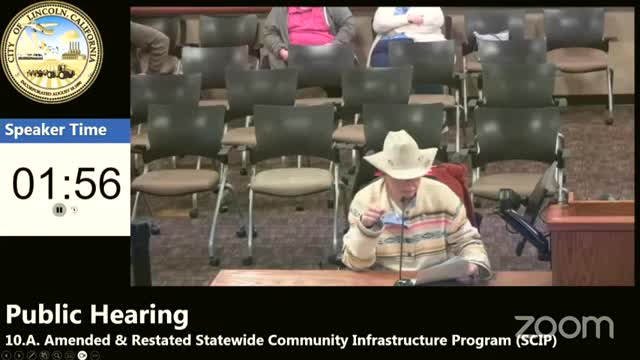City Council discusses finance options for new homebuyers in Lincoln
January 24, 2024 | Lincoln, Placer County, California

This article was created by AI summarizing key points discussed. AI makes mistakes, so for full details and context, please refer to the video of the full meeting. Please report any errors so we can fix them. Report an error »

During the recent City Council meeting in Lincoln, California, significant discussions centered around the financing of public infrastructure for new home developments. A key point raised was the impact of Community Facilities Districts (CFDs) on homebuyers, particularly regarding how these special taxes can affect overall housing costs.
Council members and community members engaged in a detailed dialogue about the implications of higher property tax bills versus mortgage rates. One resident expressed concern about the rising costs of new homes, which often exceed $500,000, and sought clarification on the financial structures that accompany these purchases. The resident emphasized the importance of understanding how additional costs, such as taxes and fees, are presented to potential buyers.
City officials explained that developers are acutely aware of the financial thresholds that homebuyers can manage. They often use CFDs as a tool to distribute the costs of infrastructure across the community, which can help keep mortgage payments lower. This method allows for the costs to be spread out over time, potentially making homeownership more accessible.
The discussion also highlighted the importance of transparency in the home buying process. Council members noted that real estate professionals should provide potential buyers with clear information about property taxes and any additional costs associated with new developments. This transparency is crucial for helping buyers make informed decisions.
Moreover, it was clarified that the funds collected through CFDs are not new revenues for the city but are instead used for bond repayments, ensuring that the financial implications are well understood by the community.
As Lincoln continues to grow, the council's commitment to addressing these financial concerns will play a vital role in shaping the housing landscape and ensuring that new developments remain accessible to residents. The ongoing dialogue around these issues reflects the city's proactive approach to managing growth while considering the financial realities faced by homebuyers.
Council members and community members engaged in a detailed dialogue about the implications of higher property tax bills versus mortgage rates. One resident expressed concern about the rising costs of new homes, which often exceed $500,000, and sought clarification on the financial structures that accompany these purchases. The resident emphasized the importance of understanding how additional costs, such as taxes and fees, are presented to potential buyers.
City officials explained that developers are acutely aware of the financial thresholds that homebuyers can manage. They often use CFDs as a tool to distribute the costs of infrastructure across the community, which can help keep mortgage payments lower. This method allows for the costs to be spread out over time, potentially making homeownership more accessible.
The discussion also highlighted the importance of transparency in the home buying process. Council members noted that real estate professionals should provide potential buyers with clear information about property taxes and any additional costs associated with new developments. This transparency is crucial for helping buyers make informed decisions.
Moreover, it was clarified that the funds collected through CFDs are not new revenues for the city but are instead used for bond repayments, ensuring that the financial implications are well understood by the community.
As Lincoln continues to grow, the council's commitment to addressing these financial concerns will play a vital role in shaping the housing landscape and ensuring that new developments remain accessible to residents. The ongoing dialogue around these issues reflects the city's proactive approach to managing growth while considering the financial realities faced by homebuyers.
View full meeting
This article is based on a recent meeting—watch the full video and explore the complete transcript for deeper insights into the discussion.
View full meeting
